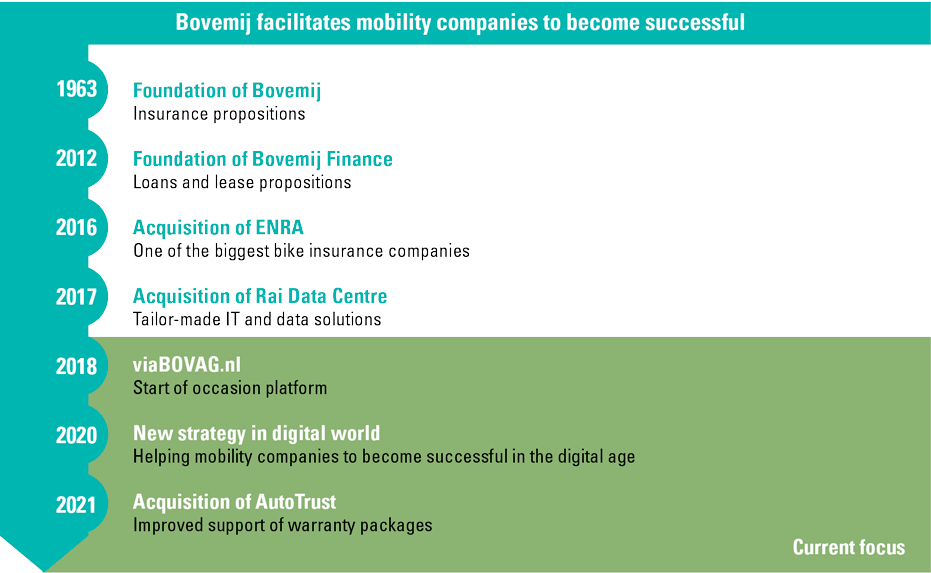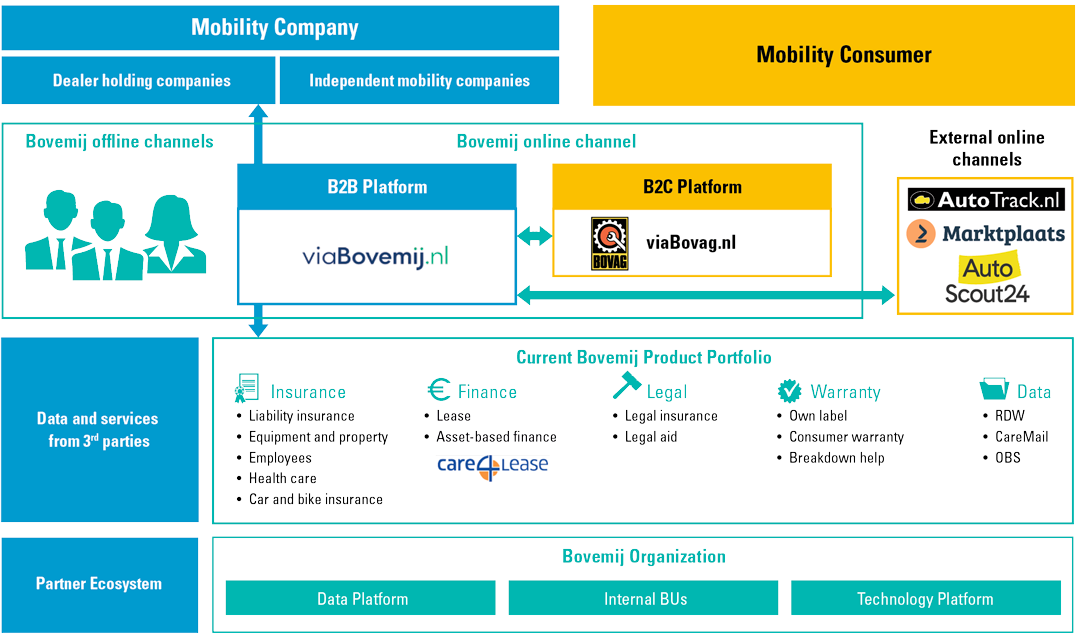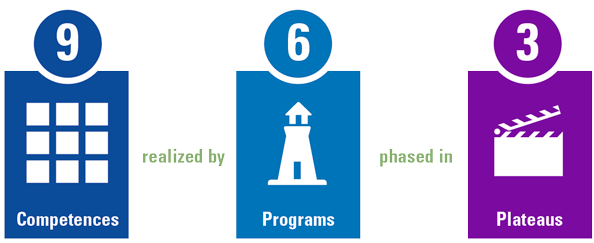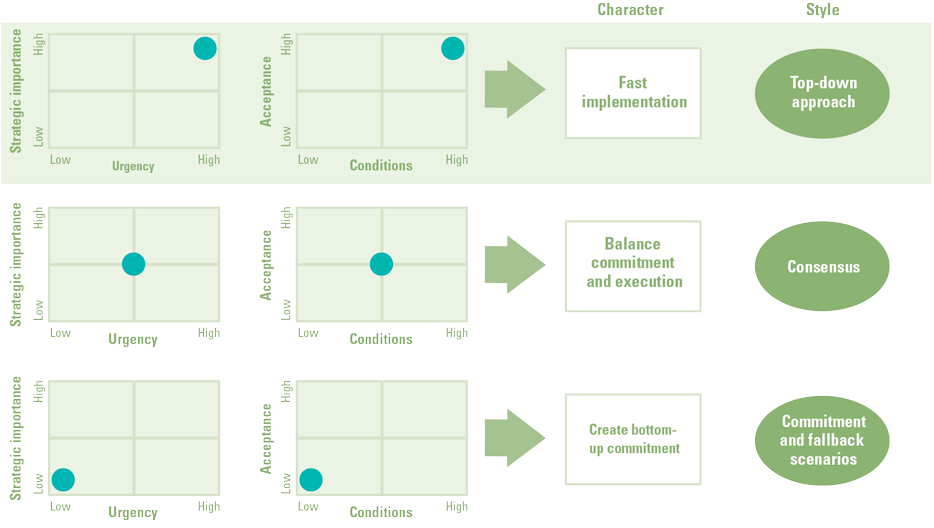For almost 60 years, Bovemij has been providing financial and other business services to mobility companies in the Netherlands with the aim to help them compete successfully in the market place. In order to keep fulfilling this mission in a world that is quickly turning digital, Bovemij developed a new digital strategy that is now in the early stages of implementation. It is already clear that these changes will bring about an almost complete overhaul of the way Bovemij operates.
The business transformation that is underway is very ambitious in its goals, requires changes that have an impact throughout the organization and needs to be executed with urgency in order to keep up with market developments. But there is no viable alternative. This transformation will elevate Bovemij to the Champions League, which is the level that is needed as a professional player in the competitive arena of digital platform companies.
An introduction to Bovemij
Bovemij was founded in 1963 as the insurance company of BOVAG. It later became the sector organization of car sales companies in the Netherlands. Through a series of acquisitions, it has become the broad services provider that it is today, still owned by and working for the mobility sector. Bovemij’s mission is to connect mobility companies in the Netherlands with potential consumers and help these mobility companies to compete successfully in their markets. It offers a wide range of insurance products, financing, legal support and services, and data tools that support for example the scheduling of test drives, customer relationship management and security and access management for data. Bovemij is headquartered in Nijmegen and has almost 800 employees. In 2020, combined income from insurance premiums and data-products was around 400 million euros.
Figure 1. Development of Bovemij. [Click on the image for a larger image]
The world of Bovemij is changing fast
Several trends, on both the consumer and the market and business sides, are disrupting the mobility sector, creating pressure on the companies that form Bovemij’s constituency. One of the most profound trends on the consumer side is that new car sales are in a structural decline, in part because of the growth in private lease. The growth of second-hand car sales attracts leasing companies and OEMs to the market as new competitors for car dealerships and independents. Younger and more sustainability-conscious consumers are embracing sharing or peer-to-peer models for assets they use only infrequently; a trend that will further increase pressure on new car sales.
In addition, the car sales process has to a large extent shifted from showroom to online. ‘Online first’ consumers do most of their research online, and only visit a showroom to make an actual purchase when they have a clear idea of what they want and what competitive pricing levels are. Some OEMs already offer a fully online sales option, where the mobility company only acts, for a fee, as the delivery point. The rise of the online first consumer also leads to a separation of sales, where the consumer searches in a wide area, and after-sales, as they remain locally oriented for maintenance and repairs. DIY consumers are comfortable managing their affairs with mobility companies, like appointments for test drives and annual inspections, digitally and independently.
On the market and business side, there is clear trend towards consolidation among mobility companies who are in search of economies of scale. Bigger players – dealership companies, importers and OEMs – all strive to attract a bigger share of the consumer business. Data and technology are becoming more important sources of value in this digital age. Only the largest mobility companies however have the scale and the knowledge required to benefit from this, most others depend on a collective approach for this. OEMs of course recognize the value that lies in the data that their cars and other types of vehicles generate and are keeping this data to themselves, restricting access for others. Similar trends regarding data and technology occurs at other vehicles (bikes, trucks, motorbikes, campers, etc) that Bovemij supports.
New competitors and entrants in the mobility sector are responding to these developments as well and launch new initiatives: trade platforms that facilitate B2C, C2B and B2B transactions, software companies that offer Dealer Management Systems and ERP systems and niche applications, data and data analytics providers, and service providers that specialize in additional services around financing, telemetry, marketing or maintenance.
Figure 2. Consumer trends and market development in mobility. [Click on the image for a larger image]
A common theme in these trends is that customer relationships are being redefined. This requires Bovemij to respond in a way that enables the mobility companies it serves to preserve and strengthen their existing customer relationships and help them establish new ones.
Bovemij’s response: a vision for the digital future
A number of years ago, Bovemij recognized these trends and the challenges they presented, both to its member companies and to itself. Bovemij realized it needed to be able to connect to consumers in the digital world and link them digitally to mobility companies to keep fulfilling its mission of helping these companies to compete in an increasingly digital world. The vast majority of these companies have neither the scale, nor the financial means nor the expertise to ‘go digital’ on their own. This meant that there was an opportunity and a need for Bovemij to develop a collective response on behalf of the companies that Bovemij serves.
The development of a vision and the first steps towards its realization have taken place under the leadership of former CEO René Leander, who stepped down on October 1st, 2021. New hires for the Executive Board have been made based on this vision. The vision was discussed and validated with mobility companies, and the commitment and buy-in from the Supervisory Board and shareholders was obtained. And while the financial results in recent years suggest that business is going well, a clear sense of urgency underpin this vision. Because with digital platforms, scale and speed are key. If you do not achieve scale quickly, competitors will do so before you and there is no place in the market for you as platform number 4 or 5. So Bovemij management is convinced that if it acts now and quickly, it would be able to secure relevancy to the sector for the foreseeable future. To turn the vision into reality and do so under considerable time pressure, Bovemij management needed to mobilize all the execution power within the organization.
Getting a digital transformation into gear
Bovemij management decided to attract a Chief Digital and Operations Officer in the Board. Soon after recruitment, the contours of a new digital strategy were drafted in six weeks and a data strategy drawn up a few weeks later. To this day, a year into the execution stage, these plans serve as the compass for day-to-day decision making. For Bovemij, these plans represented a huge step. In terms of IT, data and digital readiness, it played at second division level. If executing is successful, these plans will elevate Bovemij to Champions League, which is the level to be at as a professional player with a digital platform strategy.
The core of Bovemij’s strategy involves the development of two platforms, one named viaBOVAG.nl that serves as the consumer portal, the other named viaBovemij.nl that is aimed at mobility companies. The platforms rest on a common technology base and are supported by a single data layer. Both are to be filled with propositions, products and services that are either developed in-house, or sourced from suppliers and partners. The platforms link mobility companies digitally to consumers and create new value for both.
Figure 3. Two platforms of Bovemij to realize the strategy. [Click on the image for a larger image]
Of crucial importance in developing this new Bovemij architecture is that it facilitates mobility companies to compete in the digital era. It enables them to connect with consumers digitally and enrich the relationships they have with their customers. Collectively, through Bovemij, they will be able to retain control of the processes through which their customers are served and, to the extent that it is legally possible, all the data involved. These elements that are necessary for mobility companies to remain competitive in a digital world, and for Bovemij to continue to create added value for their stakeholders.
The route that Bovemij travels in its digital transformation is planned to take five years and has been divided into three stages. After the first of these Bovemij reaches the ‘Ready for Digital’ plateau, a milestone that is set for the end of 2021. In this stage, the foundation is laid for the subsequent roll-out of the B2C and B2B platforms and it touches almost every aspect of the Bovemij organization. This is an essential point: Bovemij is not involved in a digital transformation alone, the steps it is taking amount to a complete business transformation. A new organizational structure is put in place, technology options, partners and suppliers are evaluated and selected, new teams and agile ways of working are introduced, and people are appointed to newly created key positions. All these elements will have to be in place before the next stage in the digital transformation, in which the new Bovemij platforms will be filled with all the new propositions.
Figure 4. Digital strategy building blocks. [Click on the image for a larger image]
In addition to the construction of this foundation, stage 1 also includes an early test of Bovemij’s new strategy. Bovemij needs proof that its platform strategy not only looks good in theory; it is also able to deliver real results in practice. This is called the ‘Proof of Life’. It is meant to show how something that works on the consumer side is also beneficial to the mobility companies and that by linking both sides Bovemij can indeed generate new value for both and demonstrate its own added value. In September, Bovemij held the first successful car auction in which mobility companies had the opportunity to bid on used cars that were offered for sale. This auction was conducted entirely on the new platforms. It demonstrates how Bovemij can offer unique propositions by connecting mobility companies to consumers in the digital world, in a way that adds value to both sides.
Dilemmas, strategies and tactics
How do you turn a team, in terms of its digital capabilities, into a Champions League calibre platform organization in only five years? Or: How do you lead and manage a digital transformation that is so ambitious in its goals, so profound in its impact on an organization and so crucial for its future success? What are some of the dilemmas you encounter, and what strategies and tactics can you employ to deal with these and continue to make progress? How do you prevent an approach that some would view as quite risky from running off the rails? Bovemij defined five guiding principles for the execution of its digital transformation (see Figure 5).
Figure 5. Guiding principles for the execution of the digital transformation. [Click on the image for a larger image]
These principles are proving their value in managing the many aspects of Bovemij’s digital transformation:
- Leadership and change approach.
Bovemij was already late in starting the transformation. Speed is therefore essential. The management team was in agreement and confident on where to go and what to do and how to get there. The challenge was to push the rest of the organization towards this goal. Management decided it needed to adopt a leadership style with more of a top-down approach than the organization was used to. Otherwise Bovemij would never have achieved the speed of decision making and progress that it made today. Bovemij realizes that sometimes it wants to go too fast, but that’s not always a bad thing. Sometimes a bit of a shock is needed to create movement, new ideas and new energy that are necessary to make a leap forward. For this approach to be successful, it is essential to continuously monitor how the rest of the organization is coming along and whether there is enough of a support base to carry on. For this purpose, Bovemij created a sounding board with 25 employees from across the company that provide feedback on how well the organization is coming along. - Stakeholder management.
Maintaining the trust and the support from Bovemij’s shareholders and the mobility companies during the transformation is vital for its progress and ultimately its success. It takes time and effort from management, perhaps even more than it realized at the start, to communicate with the stakeholders about the vision for Bovemij in the digital future, the rationale for the steps that will be taken and the benefits these will bring for the stakeholders. This is an ongoing activity. - Developing partner and supplier ecosystems.
Bovemij came to realize early on that achieving the digital future by its own organizations would be very difficult or, at least not with the speed needed and against affordable cost. Bovemij needed expertise and efficiency of external partners and suppliers. This is true for the first stage of the transformation where the foundation is built, but also for the next stages when the platform is filled with new products and services. - Appoint new leadership from within Bovemij.
While hiring people from outside to bring in new competencies is sometimes necessary, Bovemij decided to fill key positions in the new organization as much as possible with internal people. This means looking for younger people, say 30 to 40 years old who, if needed, are able and willing to develop the skills and capabilities they need in their new positions. It is a deliberate choice to invest in the development of your own people and organization, rather than to hire more experienced outsiders. This is of course a more difficult and time-consuming route, but Bovemij’s management believes it will pay off in terms of greater acceptance and success of all the planned changes.
Figure 6. Opportunities to realize synergy and harmonization. [Click on the image for a larger image]
Conclusion
Digital transformations are hardly ever finished; the speed with which technology and online consumers’ preferences keep changing ensure that there is always work left to be done and new opportunities to be grasped. In the case of Bovemij one might say its digital transformation has hardly even begun, despite all efforts and the changes in virtually all aspects of the organization. It has been putting a solid foundation in place on which the new digital Bovemij will be constructed in the years to come. This next stage in Bovemij’s transformation will be about filling its platforms with products and services that will help the mobility companies it serves to succeed in the digital age. This stage will bring its own share of opportunities and dilemmas to be resolved. Which products and services will be developed in-house, and which will be sourced from external suppliers and partners? How to facilitate both the more advanced mobility companies that operate nationwide and the more old-fashioned local car dealership in their efforts to go digital? How to allocate resources between initiatives that will increase short-term profits and those that are necessary with a view on long-term value creation? Finding the right balance in handling issues like this will be key for Bovemij to succeed in its ambition to become a digital platform player at Champions League level, and whether it can continue to fulfill its mission: helping mobility companies connect with their customers in the digital age.












